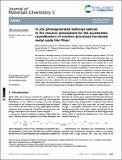Por favor, use este identificador para citar o enlazar a este item:
http://hdl.handle.net/10261/338444COMPARTIR / EXPORTAR:
 SHARE SHARE
 CORE
BASE CORE
BASE
|
|
| Visualizar otros formatos: MARC | Dublin Core | RDF | ORE | MODS | METS | DIDL | DATACITE | |

| Título: | In situ photogenerated hydroxyl radicals in the reaction atmosphere for the accelerated crystallization of solution-processed functional metal oxide thin films |
Autor: | Gómez-López, Alicia; Rivas, Y. Andrea; López-Fajardo, Sergio; Jiménez, Ricardo CSIC ORCID; Ricote, J. CSIC ORCID ; Pecharromán, Carlos CSIC ORCID CVN ; Montero, Isabel CSIC ORCID ; Bretos, Íñigo CSIC ORCID; Calzada, M. L. CSIC ORCID | Fecha de publicación: | 9-ene-2023 | Citación: | Journal of Materials Chemistry C 11: 2619- 2629 (2023) | Resumen: | [EN] We propose a disruptive method to process metal oxide thin films whereby hydroxyl radicals (˙OH) are photogenerated in situ from the atmosphere where the corresponding solution-deposited layers are UV-irradiated. The reaction of these radicals with the film results in the transformation of the deposited layer into a highly-densified amorphous metal-oxygen network that easily evolves to the crystalline film at much lower temperatures than those traditionally used (over 600 °C). An exhaustive study has allowed us to determine the underlying mechanisms involved in the accelerated crystallization of these oxides by the presence of ˙OH radicals during the process. We demonstrate that the method is applicable to all-solution metal oxide thin films, validating its general application in thin films of the binary BiO oxide and of more complex oxides like BiFeO and Pb(ZrTi)O ferroelectric perovskites. It is shown that the metal oxide crystallization occurs between 250 °C and 350 °C, a temperature range hundreds of degrees below their conventional processing temperatures and fully compatible with their direct growth on flexible polymer substrates. This processing method opens new opportunities for the integration of high-performance multifunctional oxide layers into the next-generation devices demanded today by emerging technologies such as flexible or wearable electronics. | Versión del editor: | http://dx.doi.org/10.1039/d2tc05447g | URI: | http://hdl.handle.net/10261/338444 | DOI: | 10.1039/d2tc05447g | Identificadores: | doi: 10.1039/d2tc05447g issn: 2050-7534 |
| Aparece en las colecciones: | (ICMM) Artículos |
Ficheros en este ítem:
| Fichero | Descripción | Tamaño | Formato | |
|---|---|---|---|---|
| d2tc05447g (2).pdf | 5,57 MB | Adobe PDF |  Visualizar/Abrir | |
| d2tc05447g1.pdf | Supporting_Information | 2,53 MB | Adobe PDF |  Visualizar/Abrir |
| d2tc05447g2.pdf | Supporting_Information | 2,36 MB | Adobe PDF |  Visualizar/Abrir |
CORE Recommender
Page view(s)
25
checked on 27-abr-2024
Download(s)
28
checked on 27-abr-2024
Google ScholarTM
Check
Altmetric
Altmetric
Este item está licenciado bajo una Licencia Creative Commons

